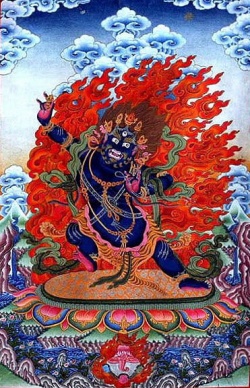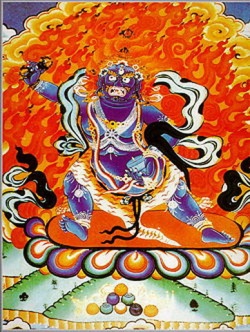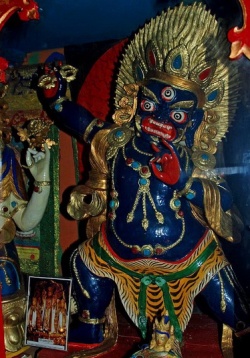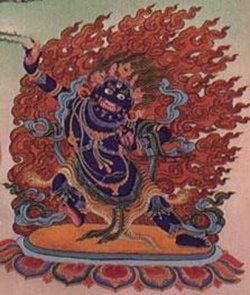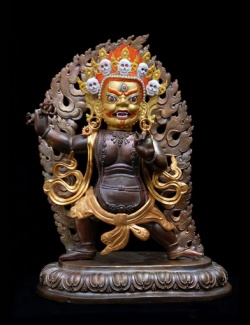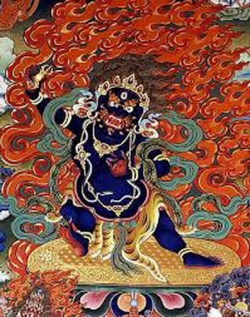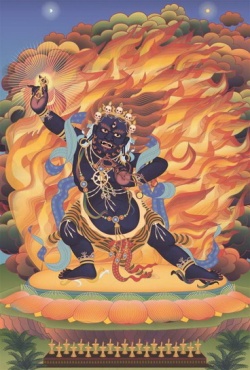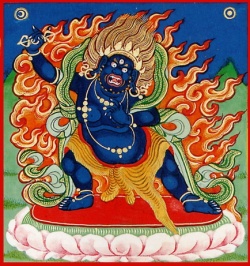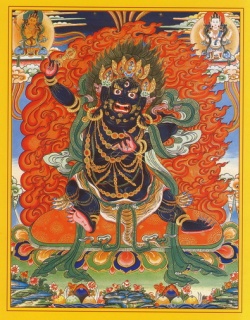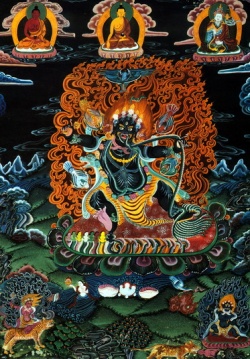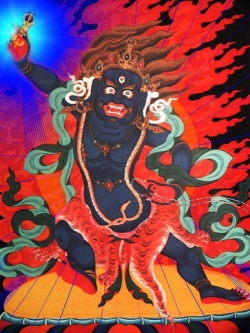Vajrapani
Click here to see other articles relating to word Vajrapani

Vajrapāṇi (from Sanskrit Vajra, "thunderbolt" or "diamond" and pāṇi, lit. "in the hand") is one of the earliest Bodhisattvas of Mahayana Buddhism.
He is the protector and guide of The Buddha, and rose to symbolize The Buddha's Power. Vajrapani was used extensively in Buddhist iconography as one of the three Protective deities surrounding The Buddha.
Vajrapāṇi (Sanskrit: Thunderbolt-Bearer) is believed to be the protector of the nāgas (half-man, half-serpent deities) and sometimes assumes the shape of a bird in order to deceive their traditional enemy, the hawklike Garuḍa. Because of his association with the rain-controlling nāgas and with the Hindu god of rain, Indra, he is invoked in times of drought.
Like Indra he holds the thunderbolt and is coloured dark blue or white. His statues are often found in a triad with the Buddha Amitāyus (or the bodhisattva of wisdom, Mañjuśrī) and the lotus-bearing bodhisattva of compassion, Padmapāṇi. In Tibet he assumes ferocious forms to combat demons and to guard the mystical teaching of Buddhism, and in Japan he guards the temple doorways (see Ni-ō).
Each of them symbolizes one of The Buddha's virtues:
Manjusri (the manifestation of all the Buddhas' Wisdom),
Avalokitesvara (the manifestation of all the Buddhas' Compassion) and
Vajrapani (the manifestation of all the Buddhas' Power as well as the Power of all 5 Tathagathas).
Furthermore, Vajrapani is one of the earliest Dharmapalas and the only Buddhist Deity to be mentioned in the Pali Canon as well as be worshiped in the Shaolin Temple, Tibetan Buddhism, and even Pure Land Buddhism (where he is known as Mahasthamaprapta and is one of a Triad comprising Amitabha and Avalokiteshwara).
Manifestations of Vajrapani can also be found in many Buddhist temples in Japan as Dharma Protectors called Nio.
Vajrapani is also associated with Acala who is venerated as Fudo-Myo in Japan where he is serenaded as the holder of the Vajra.
Vajrapani here is different from that mentioned in the Vedas as Indra, the king of the Gods and the most widely mentioned Deity in all of the Indian scriptures.
In the Sutra tradition of Mahayana Buddhism the bodhisattva Vajrapani is regarded as one of the Eight Heart-sons of Shakyamuni Buddha and portrayed in a peaceful appearance.
In the tradition of Vajrayana Buddhism, Vajrapani is more typically shown in a wrathful form and known as Guhyapati - 'the Lord of Secrets.' He is the said to be the main recipient, holder, and protector of all the Tantra texts, literature, and teachings received from the Buddha Shakyamuni (in the appearance of Vajradhara Buddha).
From the model of the Lower Tantras Vajrapani symbolizes the body of all buddhas of the ten directions and three times and represents enlightened activity. The bodhisattva Manjushri represents mind and Avalokiteshvara that of speech.
In Tantric practice Vajrapani is a meditational deity, and considered a Buddha, with numerous forms found in all of the four levels of Tantra classification and popular in all traditions of Tibetan Buddhism - new and old.
The two wrathful forms of Vajrapani known as the Sutra Tradition (do lug) and the Nilambhara (dro zang lug), each with one face and two hands, do not have skull crowns or wrathful ornaments such as the fifty freshly severed heads. They do however wear the eight races of nagas depicted as snakes - bracelets, anklets, etc.
Mahachakra Vajrapani is sometimes depicted with a skull crown and at other times shown with a jeweled crown. Almost all of the other wrathful forms of Vajrapani have the same fearsome regalia as typical of wrathful Tantric deities such as Vajrabhairava, Vajrakila, Mahakala and the like. The various forms of Vajrapani as a meditational deity are derived from the textual sources of the early Tantras.
Names
In Sanskrit, Vajrapani is also known as Vajra-sattva. The Sutra of Golden Light entitles him "great general of the Yakshas". Other name-forms are as follows.
- Bengali: Bojropani (বজ্রপাণি)
- Tibetan: Channa Dorje
- Mandarin: Jīngāng shǒu púsà (金剛手菩薩), Héyíluóhuányuèchā (和夷羅洹閱叉) or Báshéluóbōnì (跋闍羅波膩)
- Vietnamese: Kim cương thủ bồ tát, Hoà di la hoàn duyệt xoa or Bạt xà la ba nị
- Malay and Indonesian: Wajrapani
- Mongolian: Ochirvaani (Очирваань) or Bazarvaani (Базарваань)
- Korean: Geumgang su bosal (금강수보살) or Balsarapani (발사라파니)
- Japanese: Kongō shu bosatsu (金剛手菩薩), Wairaoneisa (和夷羅洹閱叉) or Bajarahaji (跋闍羅波膩)
Doctrine
On the popular level, Vajrapani, Holder of the Thunderbolt Scepter (symbolizing the Power of Compassion), is the Bodhisattva who represents the Power of all the Buddhas, just as Avalokitesvara represents their great Compassion, Manjushri their Wisdom, and Tara their miraculous deeds.
For the yogi, Vajrapani is a means of accomplishing fierce determination and symbolizes unrelenting effectiveness in the conquest of negativity.
His taut posture is the active warrior pose (pratayalidha), based on an archer's stance but resembling the en garde position in Western fencing.
His outstretched right hand brandishes a Vajra and his left hand deftly holds a lasso - with which he binds demons. Although he wears a skull crown in a few depictions, in most depictions he wears a 5 pointed Bodhisattva crown to depict the Power of the 5 Tathagathas.
(The skull crown is an iconographic Symbol of another similar Dharmapala called Mahakala). Vajrapani's expression is wrathful and he has a third Eye.
Around his neck is a serpent necklace and his loin cloth is made up of the skin of a tiger, whose head can be seen on his left knee.
The Pali Canon's Ambattha Suttanta, which challenges the Caste system, tells of one instance of him appearing as a sign of The Buddha's Power.
At the behest of his teacher, a young Brahmin named Ambatha visited The Buddha.
Knowing The Buddha's family to be the Shakya clan who are Kshatriya Caste, Ambatha failed to show him the respect he would a fellow Brahmin.
When The Buddha questioned his lack of respect, Ambatha replied it was because The Buddha belongs to a "menial" Caste. The Buddha then asked the Brahmin if his family was descended from a “Shakya slave girl”.
Knowing this to be true, Ambatha refused to answer the question.
Upon refusing to answer the question for a second time, The Buddha warned him that his head would be smashed to bits if he failed to do so a third time.
Ambatha was frightened when he saw Vajrapani manifest above The Buddha's head ready to strike the Brahmin down with his thunderbolt. He quickly confirmed the Truth and a lesson on Caste ensues.
According to the Pancavimsatisahasrika and Astasahasrika Prajnaparamita any Bodhisattva on the Path to Buddhahood is eligible for Vajrapani's protection, making them invincible to any attacks "by either men or Ghosts".
Mantras
The Mantra oṃ Vajrapāṇi hūṃ\ phaṭ is associated with Vajrapani. His Seed Syllable is hūṃ.
The combined power and energy of all the Buddhas,
Supreme holder of the treasure of the Secret Teachings,
Subjugator of all maras and obscurers without exception;
I praise and pay homage to Vajrapani
DE SHEG THU TOP CHIG DU SHING
SANG WA NGAG KYI DZO DZIN CHOG
DU GEG MA LU DUL DZE PA
DORJE DZIN LA CHAG TSEL TÖ
Patron saint of Shaolin Monastery

In his book The Shaolin Monastery (2008), Prof. Meir Shahar notes Vajrapani is the patron saint of the Shaolin Monastery.
A short story appearing in Zhang Zhuo's (660-741) Tang anthology shows how the Deity had been venerated in the Monastery from at least the eighth century.
It is an anecdotal story of how the Shaolin Monk Sengchou (480-560) gained supernatural strength and fighting ability by praying to the Vajrapani and being force-fed raw meat.
Shaolin abbot Zuduan (1115–1167) erected a stele in his honor during the Song Dynasty. It reads:
- According to the scripture Lotus Sutra, this Deity (Narayana) is a manifestation of Avalokitesvara (Guanyin).
If a person who compassionately nourishes all living beings employs this [[[deity's]]] charm, it will increase his Body's strength (zengzhang shen li).
It fulfills all vows, being most efficacious. ...
Therefore those who study Narayana's hand-symbolism (Mudra), those who seek his spell (Mantra), and those who search for his image are numerous. Thus we have erected this stele to spread this Transmission.
- — Stele re-erected (chong shang) by Shaolin's abbot Zuduan
Instead of being considered a stand alone Deity, Shaolin believes Vajrapani to be an emanation of the Bodhisattva Guanyin.
The Chinese scholar A'De noted this was because the Lotus Sutra says Guanyin takes on the visage of whatever being that would best help pervade the Dharma.
The exact Lotus Sutra passage reads: “To those who can be conveyed to Deliverance by the Body of the Spirit who grasps the Vajra (Vajrapani) he preaches Dharma by displaying the Body of the Spirit who grasps the Vajra.”
He was historically worshiped as the progenitor of their famous staff method by the Monks themselves.
A stele erected by Shaolin abbot Wenzai in 1517 shows the Deity's Vajra-club had by then been changed to a Chinese staff, which originally "served as the emblem of the Monk". Vajrapani's Yaksha-like Narayana Form was eventually equated with one of the four staff-wielding "Kimnara Kings" from the Lotus Sutra in 1575. His name was thus changed from Narayana to "Kimnara King".
One of the many versions of a certain tale regarding his creation of the staff method takes place during the Yuan Dynasty's Red Turban Rebellion.
Bandits lay siege to the Monastery, but it is saved by a lowly kitchen worker wielding a long Fire poker as a makeshift staff.
He leaps into the oven and emerges as a monstrous giant big enough to stand astride both Mount Song and the imperial fort atop Mount Shaoshi (which are five miles apart).
The bandits flee when they behold this staff-wielding titan.
The Shaolin Monks later realize that the kitchen worker was none other than the Kimnara King in disguise.
Shahar notes the part of the kitchen worker might have been based on the actual Life of the Monk Huineng (638-713).
In addition, he suggests the mythical elements of the tale were based on the fictional adventures of Sun Wukong from the Chinese epic Journey to the West.
He compares the worker's transformation in the stove with Sun's time in Laozi's crucible, their use of the staff, and the fact that Sun and his weapon can both grow to gigantic proportions.
Statues and paintings of Kimnara were commissioned in various halls throughout Shaolin in honor of his defeat of the Red Turban army.
A wicker statue woven by the Monks and featured in the center of the "Kimnara Hall" was mentioned in Cheng Zongyou's seventeenth century training manual Shaolin Staff Method.
However, a century later, it was claimed that Kimnara had himself woven the statue. It was destroyed when the Monastery was set aflame by the KMT General Shi Yousan in 1928.
A "rejuvenated religious cult" arose around Kimnara in the late twentieth century. Shaolin re-erected the shrine to him in 1984 and improved it in 2004.
The Buddhist monk Bodhidharma erroneously came to be known as the creator of the Monastery's arts.
This occurred when a Taoist with the pen name "Purple Coagulation Man of the Way" wrote the Sinews Changing Classic in 1624, but claimed to have discovered it.
The first of two prefaces of the manual traces this qigong style's succession from Bodhidharma to the Chinese general Li Jing via "a chain of Buddhist saints and martial heroes."
Scholars damn the work as a forgery because of its numerous anachronistic mistakes and the fact that popular fictional characters from Chinese literature, including the "Bushy Bearded Hero" (虬髯客), are listed as lineage masters. In fact, the Qing scholar Ling Tingkan (1757–1809) "dismissed the manual's author as an 'ignorant village master'."
Iconography
Just as Buddhaghosa associated Vajrapani with the Hindu God Indra, his first representations in India were identified with the thunder Deity.
As Buddhism expanded in Central Asia, and fused with Hellenistic Influences into Greco-Buddhism, the Greek hero Hercules was adopted to represent Vajrapani.
He was then typically depicted as a hairy, muscular athlete, wielding a short "diamond" club.
In Japan, Vajrapani is known as Shukongōshin (執金剛神, "Diamond rod-wielding God"), and has been the inspiration for the Niō (仁王, lit. Benevolent kings), the wrath-filled and muscular guardian God of The Buddha, standing today at the entrance of many Buddhist temples under the appearance of frightening wrestler-like statues.
He is also associated with Fudo-Myo, an incarnation of Acala and the prayer Mantra for Fudo Myo references him as the powerful wielder of the Vajra.
Some suggest that the War Deity Kartikeya, who bears the title Skanda is also a manifestation of Vajrapani, who bears some resemblance to Skanda because they both wield vajras as Weapons and are portrayed with flaming halos.
He is also connected through Vajrapani through a theory to his connection to Greco-Buddhism, as Wei Tuo's image is reminiscent of the Heracles depiction of Vajrapani.
Source
Vajrapani doesn't, to many newcomers to Buddhism, look very Buddhist at all. He is a Bodhisattva who represents the energy of the enlightened mind, and his mantra also symbolizes that quality.
Vajrapani is pictured dancing wildly within a halo of flames, which represent transformation.
He holds a vajra (thunderbolt) in his right hand, which emphasizes the power to cut through the darkness of delusion. Vajrapani looks wrathful, but as a representation of the enlightened mind, he's completely free from hatred.
Vajrapani's mantra is simply his name, which means "wielder of the thunderbolt", framed between the mystical syllables Om and HÅ«m.
This mantra helps us to gain access to the irrepressible energy that Vajrapani symbolizes. A familiarity with Vajrapani does, of course, help here, although the sound of the mantra is itself rather energetic.
Pronunciation notes:
a is pronounced as u in cut
Ä is like a in father
j is hard, like j in judge
uu is long, like oo in book
m in hum is pronounced ng, as in long
The Bodhisattva Vajrapani (alternative spelling: Vajrapani)
Vajrapani is a member, along with Avalokiteshvara and Manjushri, of the trinity of Bodhisattvas known as the Three Family Protectors.
The Buddha family of which Vajrapani is the protector is the Vajra (thunderbolt) family, which includes Akshobya (the lord of the Vajra family) and Yamantaka.
Vajrapani (Holder of the Thunderbolt) represents the energy of the enlightened mind, and energy that breaks through delusion.
He dances wildly within a halo of flames, which represent the transformative power of Awakening.
He holds a vajra (thunderbolt) in his right hand, which emphasizes the power to cut through the darkness of delusion.
Non-Buddhists (and Theravadin Buddhists) seeing Vajrapani for the first time may wonder how such a wrathful-looking figure could possibly fit with the peaceful associations they have with the Buddhist tradition, although such figures are actually very common in the Mahayana and Vajrayana traditions.
Of course it's not really possible adequately to represent the qualities of Enlightenment in any image, and so even the peaceful forms of Buddhas and bodhisattvas are to some extent misleading.
Enlightened beings do not, in reality, sit around all day on lotuses smiling serenely.
The Buddha himself was fearlessly active in engaging with the other religious figures and philosophers of his day.
His fearless approach to life is perhaps characterized mostly clearly by his encounter with Angulimala, who was an infamous bandit who killed his victims and added a finger from each to the garland he wore around his neck (his name means "Garland of Fingers").
Although warned to stay away from this dangerous figure, the Buddha insisted on going into the forest to confront Angulimala, who converted to Buddhism, became a monk, and eventually became Enlightened.
Therefore, it's just as appropriate to represent an Enlightened being as dancing wildly, naked and fearless.
Another way of looking at the apparent fierceness of Vajrapani and other "wrathful" figures is to consider what a Buddha looks like from the point of view of that part of ourselves that doesn't want to change.
We may, at some level, want to meditate, to live ethically, and so on, but other parts of us are profoundly threatened by the possibility of change.
Our habits can form a kind of "sub-personality" that can try to hijack our lives.
After all, habits of denial, craving, and aversion face extinction if we continue to practice the path of mindfulness and compassion, so it's not surprising that they sometimes put up a protest. From the point of view of those powerful and yet primitive parts of ourselves, Enlightenment, rather than looking attractive, seems to be threatening and demonic.
Because of this dual nature, Vajrapani has his peaceful forms as well, and early depictions of him, while muscular and athletic, are nothing like the wild figure depicted above.
Vajrapani's' origins
Vajrapani has his origins in the Pali canon, as a Yaksha, or nature spirit.
In this story, in the Digha Nikaya, a Brahmin (priestly) youth named Ambattha, is first of all rude to the Buddha, believing him to be of a lower social caste, and then refuses to answer a question the Buddha — who is unfailingly polite in the encounter puts to him about his ancestry.
After Ambattha refuses to answer the question twice, the Buddha reminds him that there is a traditional belief that if you refuse to answer the question of an enlightened one three times, your head will split in seven pieces. Of course this never happens, but "Vajirapani" (the Pali form of his name) appears, ready to make good on the ancient prophecy. Ambattha is of course terrified and promptly answers the Buddha's question.
Vajrapani also has his mythic roots in Indra, the Indian thunder god.
He's thus connected to Zeus and Jupiter,
who, along with Indra, are all variants of the same thunderbolt-wielding sky-deity. ("Dyaus" is Sanskrit for "sky," and Indra is also known as "Indra Dyaus."
"Zeus" is the Greek form of Dyaus. Jupiter is "Dyaus-piter" or "sky father.")
The earliest depictions of Vajrapani, as we noted above, are not particularly wrathful. In this image, from the second century, both the Buddha (seated) and Vajrapani (standing) are sculpted in classic Greek style.
Vajrapani here is shown as a powerful muscular figure protecting the Buddha, and his iconography is essentially that of Herakles (Hercules).
The characteristics he shares with the later form are the vajra (thunderbolt), his powerful frame, and his semi-nakedness, which is typical of a Greek athlete.
In later forms, as Vajrapani becomes more other-worldly, he is shown as being dark blue in color. He perhaps borrows this color from Akshobhya, the head of the Vajra Family.
But this is also the color of a thunder cloud.
He represents the power, energy, and fearlessness of the Buddhas. He stands in (or rather is caught in) the warrior pose that will be familiar to those who practice Hatha Yoga.
In his outstretched right hand he wields a vajra, and his left hand holds a lasso with which to bind demons.
Vajrapani wears a loin-cloth around his hips.
The cloth is made from the skin of a tiger. He is adorned with the five-pointed Bodhisattva crown, but the crown bears five skulls. He has necklace hanging to his belly, but he also has a snake around his neck.
Snakes and dragons are associated with clouds and rain, fitting in with Vajrapani's origins as a god of thunder.
Vajrapani has a bulging third eye in the center of his forehead. Just as Ambattha's hairs stood on end when he encountered Vajirapani, so the bodhisattva's hair flies wildly in the air.
Although Vajrapani and other similar figures are often described as "wrathful" it's important to realize that they do not represent ordinary anger, but simply the power and fearlessness of the awakened mind.
There is no place in Buddhist practice for "righteous anger," and despite his appearance Vajrapani is a profoundly compassionate figure.
Source
Vajrapani (Chana Dorje>phyag.na rdo.rje) is royal blue or blue-black, and, in peaceful form, balances the dorje upon his palm or wrathful, wields a vajra (dorje) in warning as if to throw it.
In another wrathful form, he also holds a noose or fetter. In very wrathful form, he is winged.
Vajrapani (Chin: Jin Gang Shou; Jap: Kongo Shu) means "Lightning Hand," an epithet pointing to his identity with India's thunderbolt-wielding king of gods, Indra, also called Shakra (Pali: Sakka.)
This identity is borne out by his other Buddhist epithets, i.e. Vasava, Devinda, Maghava, Sahasranetra (Pali: Sahasranetta,) though in his role as a Dharma-protector, the ancient title Purindara meaning "town-wrecker" became Purinda or "town-keeper" ( R. Bannerjee.)
Indra rules the lower five of six Kama-deva-lokas and his abode is in the heaven called Trayastrimsa (Pali: Tavatimsa.)
His consort is Suja, his chariot and/or his palace is called Vijayanta (Victorious,) and his driver is called Matali.
His mount is the elephant, Airavata (Pali: Eravana.)
Vajrapani is associated with Buddha Shakyamuni and mentioned, usually by one of his other names, as the attendant who accompanied Him wherever he went.
In accounts of the Buddha's life, his presence is evoked by means of the phrase, Mighty as an Elephant or Mahasthamaprapta (Tib. Thuchenthop -- Great Strength as Elephant.)
This epithet is especially used when he is shown standing beside Amitayus (the Long-life buddha-form of Amitabha,) along with Chenrezi. In images, he is usually depicted on the left while Chenrezig is on the right of Amitayus.
(In Vietnamese, Avalokitesvara is called Quan The Am Bo Tat or Quan Am, and Mahasthanaprapta is called Dai The Chi Bo Tat.)
Bodhisattva Mahasthamaprapta was the member of the Noble Sangha who stopped a rolling boulder aimed at the Buddha while he was teaching on Emptiness at Rajgriha (Vulture's Peak.)
He therefore embodies "skillful means" or insightful technique.
Vajrapani also represents righteous wrath, an association derived from an account where, when someone behaved insolently to Buddha Shakyamuni, refusing to answer his question, he instantly appeared above his head ready to let loose a thunderbolt.
It is said that when the Tathagata subdued the gigantic naga of Udyana, he charged Vajrapani to guard the other serpents who had surrendered seeking refuge from the attack of Garuda.
He is also the enemy of the titans/demons who possessed the supreme poison halahala.
Bhutadamara "subduer of demons"
Besides being the champion of the vajra family of Buddhas, all the power of the 5 primordial buddhas are united in him.
Therefore, he is invoked to overcome interior obstacles including psychological illness, and in times of overwhelming circumstances.
In his association with tantric practices, he is sometimes called Ghuyapati or Lord of Secrets.
In Japanese, he is called Kongo; in Chinese, Da Shi Zhi
He appears also in a form in which he assimilates Hayagriva and Garuda.
That form of Vajrapani is believed to be especially effective against grave diseases. He is also associated with other wrathful deities depicted as winged.
An idea of a Vajrapani practice -- it is incomplete, and will certainly be inadequate without an empowerment and the transmission, ie. wang and lung.
Vajrapani Practice -- Tibetan
It is recommended that you receive the actual empowerment for these practices when possible.
To visualize a sun or moon disc, imagine that it is a disc shaped slice from the center of the moon or sun -- flat like a plate.
In all the practices, visualize a white light in the forehead, a red light in the throat and a blue light in the heart.
Also imagine the sound Om radiating from the forehead, the sound Ah radiating from the throat and the sound Hung radiating from the heart.
This practice subdues negative forces within and outside yourself that bother you and "eat" at your energy field -- including "the parasite" and "the flyers".
It should be performed as energetically as possible. Visualize a lotus throne and a sun and moon disc upon which sits a shining blue sphere of light giving off the sound Huuunnnng.
Suddenly the light transforms itself into yourself as an extremely wrathful figure -- green-blue with three eyes, rolling tongue and gnashing fangs -- raging with divine wrath against all forces of negativity and perversion of the truth.
In your right hand is a brilliant lightning bolt to subdue and destroy the forces of evil. Your left hand is held firmly at the heart.
Blaze with divine rage against all the forces of darkness. You are radiating blue-green light very fiercely and brightly. You dance around wildly and stomp to death all the forces of negativity while reciting the following mantra 21 times or more:
OM VAJRA TSANDA MAHA ROKHANA HUNG PHE
If you are still bothered and want to do more recite the following mantra:
GARUDA TSALE TSALE HUNG PHE
NAGADU TSANDE TSANDE MILI MILI BHANDA BHANDA
NAGANI SWA HA
Vajrapani
The Bodhisattva and Spiritual Emanation of Aksobhya
The musicality of being is the clear tone of a bell
Destroying all mist which rises from below
It is the slashing sword which rends aside the veils of ignorance
Which cuts the power of Mara
Not mercy but destruction
Do not keep it, but dissolve it
The curves of blindness are dangerous as a poisonous snake
Ignorance is not tolerated by the wise
It is eliminated
In clarity only is there truth
No being, no form, no idea
Can be more important
Purify ruthlessly, cut off the tubers
Of slimy desires which ever cling
Growing, like mold upon the pure
Swamp tendrils ever curl up the arms of the wanderer
Hands rise up out of the muck, pulling him under
Alluring eyes call him forth,
Smiles beckon, and infinities of illusions rise up to him
To pull him down.
Do not give in, do not listen to the coiling voices
They are hollow, like spiderwebs, they are empty of knowledge
They are the knots of endless form, calling down food
That they may glut themselves
Wanderer along the path to heaven
My task is to aid you
If you are pure, my sword and knowledge
Are at your disposal
If you yearn after purity, yet cannot escape
The barbed tendrils and strangling life-slime
Meditate upon me, for my life is virtuous and my mind is free
Like an icy mountain lake, or a clear autumn evening
No illusions may exist around me
I am the shining jewel where no dust may settle
I am one trunk, with no branches
I do not scatter my energy in wasteful forms
Nor do I allow clouds to rest before me
I am clarity and wisdom, without blight.
I inspire the strong and noble
Who shun deception, and favor truth
For the world is full of lies
And the clear sword of Truth is needed
To pierce its darkness.
Source
Vajrapani in his peaceful form also makes an appearance in Dewachen aspiration prayers associated with the Buddha Amitabha.
In "The Wishing Prayer of Dewachen, the Pure Realm of Great Bliss" composed by Raga Asye we find the following reference:
When at dusk the sun of the Dharma is setting, the very next morning Chenrezi will be a perfect Buddha.
He will be the "King whose light rays manifest the accumulated Splendour of all Noble Ones".
When this happens, may I see his face, make offerings and listen to the noble Dharma.
During the sixty-six trillion million aeons that he will live, may I continuously be his servant, worship him, and uphold the noble Dharma without ever forgetting to remember his words.
After he has passed into nirvana, his teaching will remain for three times six hundred billion million aeons – may I uphold the Dharma during all this time and never be separated from Vajrapani.
When Vajrapani becomes the Buddha "Completely reliable Tathagata King of abundant jewel-like qualities" with a life span and teaching just as those of Chenrezi, may we continuously be the servants of this Buddha as well, present our offerings and uphold all the noble Dharma.
When my life is over, may I instantly obtain unsurpassable perfect Buddhahood in this or one of the other pure realms.
Having obtained perfect Buddhahood, may all beings ' just as with Amitayus ' be ripened and liberated by simply hearing my name, and may there arise, through countless emanations that guide sentient beings and through other means, spontaneously and without effort a limitless benefit for beings
Source
Vajrapani (Skt. Vajrapānī; Tib. ཕྱག་ན་རྡོ་རྗེ་, Chakna Dorje; Wyl. phyag na rdo rje) — one of the eight great bodhisattvas and lords of the three families.
He represents the power of the buddhas and is usually depicted as blue in colour and holding a vajra.
He is especially responsible for transmitting the tantras to the human realm, and is known, in this context, as the 'Lord of Secrets' (Skt. Guhyapati; Tib. གསང་བའི་བདག་པོ་, Wyl. gsang ba'i bdag po).
Further Reading
- Jamgön Mipham, A Garland of Jewels, (trans. by Lama Yeshe Gyamtso), Woodstock: KTD Publications, 2008
As stated in the Vajrayana scriptures, Vajrapani is the great sphere of moonlight which emerged when Vairocana entered the Samadhi of Samantabhadra within the Diamond Mandala. This moonlight is the perfect bodhicitta seal. Amidst the moonlight there is a brilliant vajra. This transformation indicates that Vajrapani is the combined entity of Samantabhadra Bodhisattva and Vajrasattva. Consequently, Vajrapani's mudra is identical to the mudra of Samantabhadra Bodhisattva.
Vajrapani is the supreme dharma prince of all tathagatas, the very bodhicitta of all tathagatas. He is thus the supreme secret master of all tathagatas. Hence he is given the title Vajra Holder, Lord of Secrets. In fact, all enlightened vajra masters are Vajrapani himself.
Vajrapani Bodhisattva is the bodhicitta of all buddhas whereas Mahasthamaprapta Bodhisattva is the wisdom mind. Because Vajrapani Bodhisattva is the secret held in the heart of all Tantric practitioners, Vajrapani Bodhisattva is Vajra Heart Bodhisattva. It is with the heart that sentient beings attain spiritual union with all the buddhas and bodhisattvas.
Vajrasattva is known as Vajra Heart. He is also known as Vajrapani, Lord of Secrets, and Vajra Holder. Vajrapani, Vajra Heart Bodhisattva, and Vajrasattva are the Trinity of Vajrayana. These three bodhisattvas are the greatest, most significant Vajrayana bodhisattvas. Vajrasattva is the combination of these three bodhisattvas. The image of Vajrasattva depicts Vajrasattva's sambhogakaya form. Vajrapani is Vajrasattva in the form of a dharma protector. Vajra Heart Bodhisattva is a bodhisattva of the dharma realm and is the dharmakaya of Vajrasattva. In other words, the combination of a bodhisattva's Truth Body, Bliss Body, and Emanation Body is referred to as Vajrasattva. Therefore, in Vajrayana the greatest and most significant bodhisattva is Vajrasattva Bodhisattva.
The Three Protectors of Vajrayana are Avalokiteshvara, who represents compassion, Manjusri, who represents wisdom, and Vajrapani, who represents dharma power. This means that to extensively nurture one's bodhicitta one must take refuge in Avalokiteshvara. One takes refuge in Manjusri to strengthen and increase one's wisdom, that is, the wisdom of the Tathagata. Vajrapani, on the other hand, represents all the dharma power one needs to accomplish worldly activities. In Vajrayana we call these three deities the Three Protectors.
The Great Perfection has two lineages. One lineage is the heaven lineage which was passed down as follows: Samantabhadra Tathagata - the Five Dhyani Buddhas - Vajrasattva - Vajrapani - Emperor Shengxin. The other lineage is the human lineage: Prahevajra - Manjusrimitra - Shri Singha - Vairotsana - Padmasambhava - King Trisong Detsen -Yeshe Tsogyal
Tang Vajrayana began with the oral transmission from Vairocana Buddha to Vajrapani, who, after attaining supreme realization, transmitted the teachings to Nagarjuna. Nagarjuna transmitted the teachings to Nagajnana, who transmitted them to Vajrabodhi. Because Vajrabodhi came to China during the Tang Dynasty, it is called Tang Vajrayana. Vajrabodhi then transmitted the teachings to Amoghavajra who in turn transmitted them to Huilang. By the time of the Yuan Dynasty, Vajrayana in China was in decline.
In the Vajrapani mantra Om。 bie-zha。 bo-ni 。hum pei, bo-ni is Vajrapani. The two words bo-ni are of great significance. It means that Vajrapani has the greatest wisdom in the universe. Hum is his seed syllable. Pei is to dispel all misfortune. This is the meaning of his mantra.
Om, bo-ni-lan-ze-le is the Armor Protection Mantra of Vajrapani.
The Vajrapani mantra symbolizes the purification of speech, the image of Vajrapani symbolizes the purification of mind, and the mudra of Vajrapani symbolizes the purification of body. Once one's body, speech, and mind are purified one is able to be close to one's personal deity and one's protector.
Buddhist practice is all about attaining union with the principal deity. Yoga is the attainment of this union. Therefore, Vajrapani Yoga, Vajrapani Sadhana, and Vajrapani Personal Deity Practice are all actually one and the same. The critical factor is his entering into one's mind, one instantly merging with Vajrapani, and one transforming into Vajrapani. In Vajrayana, the two words spiritual union are the two most important words for principal deity practice.
One of the holy lineage tokens which Living Buddha Lian-sheng received from Guru Thubten Dargye of the Gelug sect was a clay Vajrapani statue that belonged to the 17th Kanjurwa Khutughtu. In one's wildest dreams one would never imagine that something made of clay could be so wonderfully delicate and possess such dignity. It was multicolored and smaller than the size of one's palm, just a bit larger than one's thumb. You just can't imagine. The 17th Kanjurwa Khutughtu bestowed it on Guru Thubten Dargye who then bestowed it on me.
The Vajrapani Sadhana below is the excerpt from Living Buddha Lian-sheng's Book 250, Uncanny Insight into the Unknown. Someone asked me, Grandmaster Lu, the Three Protectors of Vajrayana are Four-armed Guanyin, Manjushri, and Vajrapani. You have transmitted the practices of Four-armed Guanyin and Manjushri, why not yet of Vajrapani?
I was startled when I heard that.
I asked back, I have not transmitted Vajrapani Practice?
He replied, No.
I gave some thought to it and recalled that Master Pufang chanted the Vajrapani Mantra when he was teaching Armor Protection: Om。bo-ni。lan-zhe-li。
I had always thought that this transmitted the Vajrapani practice. I was unaware that there was still no complete sadhana available.
I am now setting out the essence of the Vajrapani sadhana as follows:
The seven steps:
Great Homage Practice Mandala Offering Practice Fourfold Refuge Practice Repentance Practice Four Immeasurable Vows Practice Armor Protection Practice Bodhicitta Practice
Vajra Mudra - Put the palms together. Interlace the ring fingers inward while the little fingers are still touching each other. Point the two index fingers outward, and press the ring fingers with the thumbs while keeping the tip of the middle fingers touching. (Similar to Golden Mother's mudra except the little fingers are straightened and touching.)
First purify oneself and empty the mind.
In a clear and empty sky appear lotuses of all different colors. Upon a lotus is a sun disc. Upon the sun disc is the syllable hum which transforms into a vajra scepter. Within the vajra scepter there is a hum syllable emitting light which subjugates all evil. The syllable hum enters the heart of the practitioner who then transforms into dark blue Vajrapani with one head and two arms. His right hand holds a vajra scepter up high with a Wrathful Fist Mudra. He also holds his left hand in front of his chest with either a Wrathful Fist Mudra or holding a lasso. He is adorned with jewels, snakes and a tiger-skin skirt. He stands in magnificent fire prajna light with his right leg bent and his left leg extended outward.
The syllable hum in Vajrapani's heart emits light and invokes Wisdom Vajrapani, the Five Buddhas, and other buddhas and bodhisattvas to descend.
Chant Za-Hum-Ban-Huo. Meditate and become one.
Chant the mantra: Om。 bie-zha。 bo-ni 。hum-pei。as many time as possible.
Enter Samadhi
Emerging from Samadhi and Praise: Homage to Vajrapani in the north Residing forever in the eternal wonderful Pure Land Praised by buddhas and a refuge for sentient beings Undertaking tathagata vows as the Lord of Secrets Eradicating all afflictions and evil Purifying the three poisons by this vajra cause
Recite the Hundred Syllable Mantra 3 times
I dedicate the merits of this practice To my swift transformation into Vajrapani May I subjugate all evil And be liberated from samsara's vast ocean of suffering
Vajrapani dharma practice has either Vajrapani single practice or Vajrapani Consort practice. The consort is Mamagayi Buddha Mother. She is blue and holds a vajra kartika and a kapala. (I will select a day to transmit this practice.)
!!Please be aware that before anyone can practice the above uncommon practices, it is advised and recommended that they take refuge and the respective empowerment; alternatively one must face inherent resulting cause and effect!!
